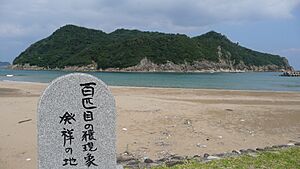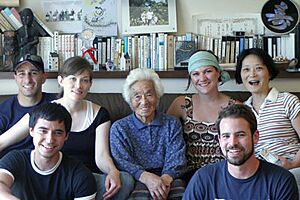Satsue Mito facts for kids
Quick facts for kids
Satsue Mito
|
|
|---|---|
| Born | April 21, 1914 Saeki-ku, Hiroshima, Japan
|
| Died | April 7, 2012 (aged 97) |
| Nationality | Japanese |
| Occupation | Primary school teacher and instructor at Kyoto University |
| Known for | Discovery of sweet potato washing and its spread among monkeys at Kōjima, Miyazaki Prefecture |
Satsue Mito (born April 21, 1914 – died April 7, 2012) was a Japanese teacher and a scientist who studied monkeys. She worked with the Kyoto University Primatology group, which studies primates like monkeys. They focused on wild monkeys living on an island called Kōjima in Miyazaki Prefecture, Japan.
Satsue Mito was very good at telling the monkeys apart. She identified every single monkey on the island and kept records of how they related to each other. She made an amazing discovery: she found out how monkeys learned to wash sweet potatoes and how this new skill spread among them. She was also an instructor at Kyoto University from 1970 to 1984, helping other researchers.
Satsue Mito's Life Story
Satsue Mito was born in what is now Itsukaichi machi, Saeki-ku, Hiroshima. After finishing Yasuda High School, she continued her studies and became a qualified teacher in 1932.
In 1934, she got married and moved to northern Korea for her teaching job. Later, in 1940, her husband passed away. She then moved to Dalian, China, with her three children and worked at a Chinese school.
In 1947, she returned to Japan and settled in Miyazaki. While still working as a teacher, she began helping the Kyoto University team that was studying monkeys. In 1969, she received an award for her contributions to science.
She retired from Nango Elementary School in 1970. After retiring, she became a full-time member of the Kyoto University team at the Kōjima Observatory. She wrote a book called Monkeys at Koshima, which won the Sankei Publication Award for children in 1972. In 1974, she also received the Eiji Yoshikawa award. Satsue Mito passed away on April 7, 2012, at the age of 97.
Discovering Monkey Behavior
Satsue Mito's father played a role in the study of Kōjima Island. In 1934, thanks to his efforts, the island and its monkeys were officially protected as a natural monument.
In 1948, scientists from Kyoto University, including Kinji Imanishi, visited the island. At first, they didn't see many monkeys. This was because hunters had likely caught many of them for money. The researchers initially observed only 9 monkeys, even though about 40 or 50 had been seen in 1934. In 1969, the Kōjima Observatory was built as part of the Kyoto University Primate Center, giving researchers a dedicated place to study.
Sweet Potato Washing
In 1954, Satsue Mito made her most famous discovery. She observed a young female monkey washing sweet potatoes before eating them. This was a new behavior! What was even more amazing was how this skill spread. Other monkeys, especially younger ones, started copying her. About 74% of the monkeys learned to wash their food. However, older monkeys, except for the young monkey's mother, did not pick up this new habit.
This discovery showed how new behaviors can spread through a group of animals. It was a big deal in the world of animal research. Some scientists from other countries, like Russia, found it hard to believe that monkeys learned this on their own and thought humans must have taught them. But Satsue Mito's careful observations proved it was a natural spread of culture among the monkeys.
Her Impact
Satsue Mito's work interested many people, even important figures. Crown Prince Naruhito (who is now the Emperor of Japan) read one of her books. Satsue Mito was invited to the home of Akihito (the previous Emperor) and his family twice to talk about the monkeys.
Her studies helped us understand more about how animals learn and share new skills, which is a very important part of Primatology.



